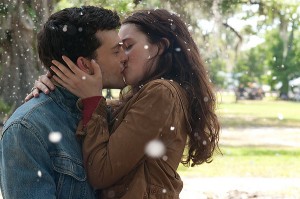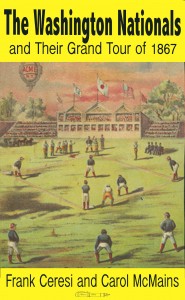Beautiful Creatures is the first of a sensationally popular series of books about a “caster” girl with magical powers and the human boy who loves her. The books are best-sellers around the world. I spoke to authors Kami Garcia and Margaret Stohl about their inspiration, their stories, and what it felt like to see their characters on screen. Kami Garcia told me she’ll be at the Bethesda Barnes & Noble on February 23, 2013 at 2 pm. They are also the founders of the YallFest, a YA authors festival in Charleston, South Carolina.
is the first of a sensationally popular series of books about a “caster” girl with magical powers and the human boy who loves her. The books are best-sellers around the world. I spoke to authors Kami Garcia and Margaret Stohl about their inspiration, their stories, and what it felt like to see their characters on screen. Kami Garcia told me she’ll be at the Bethesda Barnes & Noble on February 23, 2013 at 2 pm. They are also the founders of the YallFest, a YA authors festival in Charleston, South Carolina.
What is it about the South that makes it such an appealing setting for gothic and mysterious and romantic stories?
KG: There’s such great rich history of literature from the South. And Margy was an American Studies major and my family is from the South. I’ve always the South and she fell in love with the South. We wanted to set the story in a place that was really specific and also that felt like magic could really still happen, a place with superstition and that sort of thing. And we mostly wanted to do it so we could go there and eat pie!
MS: The low country traditionally is a logical place, where the big ships stopped and brought new things in from the ocean and the islands have a mystical tradition. It is such a visual place, too, with these iconic villages with the Spanish moss and the village and historical homes and the coast.
When you created the town, did you physically sit down and draw up a map to show where everything was in relation to everything else?
MS: We didn’t at the very first, but we are such world-builders and super-visual so that after we started we had to figure out where the houses and library were and the shop, so then we did. We had twenty locations! We did the same thing with the family tree. The scale of Southern gothic is so immense that you have to do that to keep everything straight.
I was surprised and delighted by the literary references in the movie and the books that Ethan and Lena, the two main characters read, including books by Kurt Vonnegut and Charles Bukowski.
KG: Bukowski is from my brother! Most of the books are authors that Margy and I grew up loving. To Kill a Mockingbird is our shared favorite book. Slaughterhouse Five, the poetry, those are from us, and then there are certain things we borrowed from our friends like popcorn and milk duds, that’s one of Margy’s best friends’ signature movie snack. And my brother is a big Charles Bukowski fan and Margy loves him, too. Because we weren’t writing the book to be published, it’s our families and the things that were important to us and our friends.
MS: It’s a fallacy that people think that today’s teenagers are shallow or somehow less intelligent than in the past. As we were writing we shared the books with seven teenagers who are so smart and girls who are powerful and not slutty and want things for themselves so we were writing up to them, not down.
KG: All the kids Margy and I know are independent and powerful and smart. I teach these kids. Our seven happen to be super academically smart, too, but in general, I think teens are super under-estimated. Even if they don’t get straight A’s, they’re very sophisticated in whatever their talent is. I always found as a teacher that as long as I was willing to challenge them, they would rise to the challenge.
Tell me about the challenge of writing from the perspective of a boy.
KG: We have six brothers between us. And I’ve been teaching for sixteen years. That’s another fallacy, that there aren’t boys who have that emotional side. We get boys. But if we write from the perspective of a girl, people associate that with us and not the character. We wanted to do something different.
MS: The kids told us, “We loved Twilight, but we’re done with hit.” They wanted the girl to be powerful and magical and not just fall in love with a magical and powerful boy. And we want the boy to tell the story.
KG: They said, “We want something supernatural and not just ripping off Twilight. Not vampires again, something different, something new.” Those became the rules we wrote by because we were not writing something to publish; we were writing something for them.
How did it feel to watch the movie and see your story and characters come to life?
KG: Creepy. It was so weird!
MS: I think I’ve seen it five times now, and I notice different things every time.
KG: Now we can pay attention to it like an audience. Before, it was almost like someone who had crept into our heads and saw everything in there! It was neat but it was crazy. Like when we saw the library. I thought, “How could they possibly conceive that from our description? I don’t think we’re that good!” It was so surreal to see on screen everything we were trying to do.
MS: When we went on the set and saw Jeremy Irons dressed like Macon and saying what is basically the first line of the book, our editor burst into tears.
KG: And you’re supposed to be quiet on the set! And she’s sobbing!
MS: “Get that crying girl!”
KG: The amazing thing is — we expected Jeremy Irons and Emma Thompson to be incredible but the teenagers are just astonishing. They are going to be huge! We’re so proud of them. And all those major scenes right in the beginning, they may have been intimidated but you cannot see it. Even Jeremy was talking about how remarkable they were.
MS: They don’t want to be famous. Alden Ehrenreich is a drama nerd and Alice Englert is indie girl. They’re so cool in the way that our characters are cool. They have defined interests and that’s what they shared with Jeremy, Emma — that shared passions, not wanting to be like everything else, enthusiasts for what they love.
by Frank Ceresi and Carol McMains is the amazing real-life story of a Civil War era baseball team called the Washington Nationals, filled with unforgettable characters, many baseball firsts, and some astounding artifacts.
is a collection of a headbanger’s musings, playlists, reviews and rants from metal blogger (and my son) Ben Apatoff. He says he hopes to inspire readers “to investigate, reconsider or start a fight over some of the music described herein. What are the best Iron Maiden songs about famous literature? How does Axl Rose make a small group of people cry in his presence? What happens when you play Faith No More’s Epic on a tavern jukebox? Turn the e-pages and find out.”
is retired psychoanalyst Earle Silber’s memories of growing up in a large Jewish family in Depression-era Baltimore. It is filled with vivid and evocative details from the perspective of a child and the deep insights of a man looking back on his life and family. These stories of family, school, and growing up are moving and memorable. Best-selling author Judith Viorst (Necessary Losses) says, “Earle Silber brings the sights, smells, tastes, and texture of his Baltimore childhood to vivid life in this richly detailed, lovingly recollected memoir. Generous but unsentimental, both innocent and wise, The Baker’s Son beautifully reconstructs and honors the past.”


